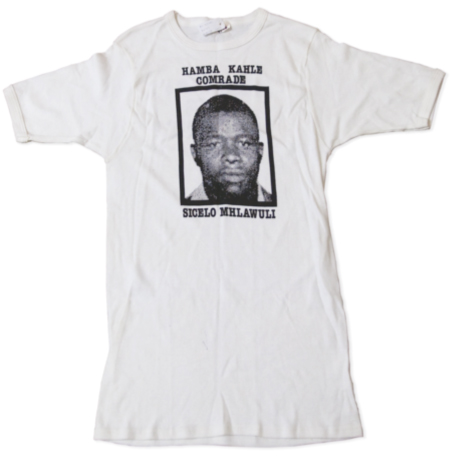|
Embodiments of Resistance: Fashioning the South African Body Politic
This collaborative project aims to consider the visual vocabulary of the liberation struggle in South Africa, as expressed in protest t-shirts archived at SAHA, in order to explore the ways in which this vocabulary can inform contemporary, socially engaged South African design, and to introduce learners, students and activists to this heritage, all within the curatorial framework of a museum.

BACKGROUND
The South African History Archive (SAHA) has in its custody significant collections of artefacts of visual resistance, with over 6000 unique South African struggle art posters, as well as ephemera dating primarily from the 1980s, including over 350 struggle t-shirts. While the majority of these visual materials date from the period between the late 1970s and the early 1990s, the earliest posters were produced by the Communist Party of South Africa in 1941 and SAHA continues to collect South African struggle t-shirts and posters from political and social movements, reflecting human rights issues to the present day.
These materials come together as a striking visual representation of the ongoing attempts of South African communities to assert their right to be heard, to challenge and demonstrate their defiance of injustice and to claim public space to assert and defend human rights in the country.
SAHA has been involved with the creation and production of two publications relating to our poster collection - Images of Defiance (1991 and 2004) and Red on Black (2007), and the history of struggle posters in South Africa, while far from comprehensive, is relatively well documented. In contrast, while it has been asserted that the "use of the t-shirt as a form of public testimony and political protest' constitutes ‘an important tradition of visual resistance that is historically specific to South Africa' , there has been little research conducted into the ways in which the struggle t-shirts form historical records, providing a rich visual telling of our history.
There is therefore a need to work with the makers of struggle t-shirts, mostly active in the 1980s, to gather more detailed information about the creation, production and distribution of such t-shirts, and their relationship to other forms of visual resistance like the posters, so as to improve and update the existing historical record.
Using the SAHA collection as a starting point to explore the role of t-shirts in the anti-apartheid struggle, SAHA, in conjunction with Frances Andrew (a fashion curator and theorist focussing on political clothing, and struggle t-shirts specifically) will conduct in-depth archival and oral history research into t-shirts as an ‘embodied practice of resistance and testimony' and the role of (often unknown) designers and artists in contributing to the liberation struggle. This research will, in turn, feed into accurate meta-data development for digitization and future research relating to resistance art in South Africa, and enable future research and reflection on how the visual vocabulary that emerges from these t-shirts informs art, craft and design today.
OBJECTIVES OF PROJECT
To document, preserve and reflect upon the history of apartheid era protest t-shirts through oral history, archival audit and curatorial processes in order to:
- Build, consolidate and profile a substantial archive on the history of struggle t-shirts to be made available to future generations.
- Encourage young designers to become more conscious of the history, role and social implications and possibilities of design in South Africa in promoting and supporting human rights initiatives;
- Support youth activists from community based organizations in designing and developing materials to promote strategic advocacy work;
- Enable learners to interact with this heritage in order to build understanding of both past and present struggles for justice in South Africa, as expressed through design;
- Promote greater understanding of the role of resistance art, as embodied in the t-shirt, in past and on-going struggles for justice in South Africa through physical and virtual exhibitions
| |